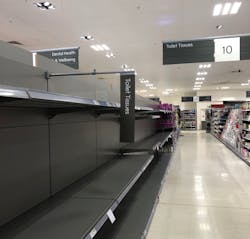In the middle of a global health crisis, the Coronavirus disease 2019 (COVID-19) pandemic portends a drastic shift in the way the world will work in the future.
Whether it’s the need to ramp up production of hand sanitizer or convert automotive plants to produce more respirators, manufacturers are under pressure now more than ever to do more with less. The production floor is operating with skeleton crews to minimize possible exposure to the virus, and plant managers are in need of a better way to maintain visibility into the process. All of this points to the potential of implementing more automation on the plant floor.
In fact, the making of toilet paper is a highly automated process, as shown in the National Geographic documentary “Chasing Paper,” which highlights Sofidel, a manufacturer of toilet paper and paper towels. So, even if operators aren’t in the plant, more paper is on its way, people, do not panic.
The biggest bottleneck in the great paper chase—or for any product right now—is the supply chain. New research indicates that a weakened supply chain is the biggest business disruption related to COVID-19.
According to ABI Research, the impact of Coronavirus is both global and unpredictable, and the supply chain shock it is causing will most definitely and substantially cut into the worldwide manufacturing revenue of $15 trillion currently forecasted for 2020 by the global tech market advisory firm.
The virus will have both short- and long-term ramifications for manufacturers. “Initially, plant managers and factory owners will be looking to secure supplies and be getting an appreciation of constraints further up the supply chain plus how much influence they have on their suppliers,” explains Michael Larner, principal analyst at ABI Research. In the longer term, manufacturers will need to conduct an extensive due diligence process as they need to understand their risk exposure, including the operations of their supplier’s suppliers. “To mitigate supply chain risks, manufacturers should not only not source components from a single supplier but also, as COVID-19 has highlighted, shouldn’t source from suppliers in a single location.”
As a result, ABI Research forecasts that the supply chain impact of COVID-19 will spur manufacturers’ spend on enterprise resource planning (ERP), to reach $14 billion in 2024. While many ERP platforms include modules for inventory control and supply chain management, in light of the outbreak, many manufacturers will also turn to specialist providers. “Supply chain orchestration requires software to be more than a system of record and provide risk analysis and run simulations, enabling manufacturers to understand and prepare for supply chain shocks,” Larner said.
ERP providers agree that COVID-19—and panic buying which quickly exhausted the supply chain—has exposed a major vulnerability in manufacturing operations.
“Business processes need to be re-evaluated as this situation has turned the supply chain on its head,” said Steve Dombroski, senior manager for the consumer, food and beverage market at QAD, a provider of adaptive ERP software. “Traditional methods of building safety stocks and buffer inventories have been replaced with Just-In-Time (JIT) item location forecasting to minimize re-deployment of inventories and to minimize inventory costs. Running JIT on inventories down and upstream through the supply chain caused delays.” This points to the need for manufacturers to address adaptability across the supply chain. “Manufacturing companies utilize two supply chains today; the physical supply chain consisting of all products and the digital supply chain that contains all information. Synchronizing both supply chains with all manufacturing, distribution, and procurement processes will enable companies to be flexible and agile.”
So, while all eyes are on automation, like robotics and Industrial Internet of Things (IIoT) sensors, to flow product through the line, none of that matters if the manufacturer doesn’t have a steady flow of raw materials. “COVID-19 demonstrates that manufacturers need to be as focused on their supplier’s capabilities as they are on their factory floor,” ABI’s Larner concludes.
For more articles on manufacturing and the Coronavirus:
Ford Motor Drives COVID-19 Medical Mission
Packaging and Processing Industry COVID-19 Resources
Opinion: Packaging Industry Begins COVID-19 Response
The COVID-19 Outbreak and Food Production
PPE and Device Manufacturers: FDA Offers Import Instructions
About the Author
Stephanie Neil
Editor-in-Chief, OEM Magazine

Leaders relevant to this article:
